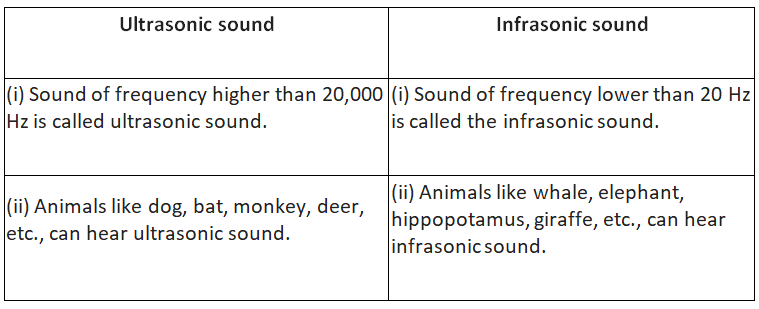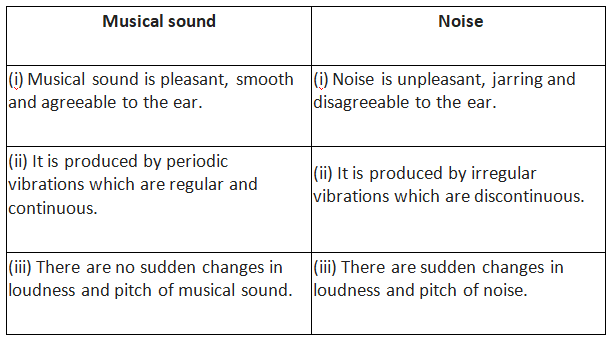Class 8 Science Chapter 11 HOTS Questions - Sound
Q1: How is sound produced and how is it transmitted and heard by us?
Ans: Sound is a form of energy produced and transmitted by a vibrating matter. It travels in form of waves through matter and moves in to and fro direction. When this wave reach eardrum it makes the eardrum to vibrate. The eardrum sends vibrations to the inner ear. From there, the signal goes to the brain and we are able to hear the sound.
Q2: Suppose a bell is ringing in a vacuum. Will you able to hear the sound?
Ans: We will not be able to hear the sound of vibration because sound cannot travel in vacuum.
Q3: What is the function of hair and wax in ear canal?
Ans: The hair and wax in the ear canal help to keep out foreign debris such as dirt and bugs.
Q4: When we speak and hear, does any part of our body vibrate? Name them.
Ans: Yes. When we speak, vocal cords vibrate to produce sound and when we hear, eardrum vibrate to receive the sound wave.
Q5: We have learnt that vibration is necessary for producing sound. Explain why the sound produced by every vibrating body cannot be heard by us.
Ans: If the sound of vibrating body is audible then only we will be able to heard it otherwise we will not be able to hear it.
Q6: Why we are able to hear sound of a clock clearer at night than in day?
Ans: The noise level is quite low at night. Therefore the sound of the clock appears much clearer at night than in the day.
Q7: On Ramesh’s 13th birthday, his father invited all his friends and their relatives. It was a big party with lots of food and DJs. Ramesh didn’t like the loud sound of DJs and asked his father to play it in a low volume so that their neighbours do not get much disturbed and people in the party can also enjoy the music. Ramesh’s father felt good for his wisdom and did as he said.
- Do you enjoy loud sound DJs in parties?
- Do you think when loud music is played in a party is acceptable to all the people living in , neighbourhood?
- How can you control noise pollution at your end?
- What value of Ramesh is shown here?
Ans:
- Yes/No (according to your choice)
- No, it may be not acceptable to all the people living in neighbourhood.
- We can control noise pollution at our end by:
- not playing music loudly.
- planting trees around house.
- cushioning gaps in windows and doors.
- using ear plugs at noisy places.
- doing meditation.
- Ramesh is wise, mature, knows hazards of noise pollution, concern about others and good-hearted.
Q8: State the differences between ultrasonic sound and infrasonic sound?
Ans:
Q9: What are the methods to control noise pollution?
Ans: Following are the methods to control noise pollution:
- The noise pollution can be controlled by reducing the respective sources of noise pollution.
- The blowing of horns and speaker should be strictly avoided near schools and hospitals.
- More and more trees should be planted on roadside because trees absorb sound.
Q10: What is the property of vibration which determines the pitch of the sound?
Ans: The frequency is the property which determines the shrillness or pitch of a sound. If the frequency of a sound is higher then we say that the sound has lower pitch.
Q11: Define frequency.
Ans: The number of oscillations completed by a vibrating body in one second is called frequency. The unit of frequency is hertz. It is denoted by Hz. If a vibrating body makes 20 oscillations in a second we say that its frequency is 20 Hz. The human voice can produce frequency between 60 Hz and 13,000 Hz. It is interesting that a human ear can hear sound of frequency between 20 Hz to 20,000 Hz.
Q12: A string musical instrument was first plucked with a force of smaller magnitude and then with a force of greater magnitude. In which case would the instrument produce a louder sound?
Ans: The loudness of sound depends upon the amplitude of vibration. The amplitude of string is larger when it is plucked with greater force and hence the sound will be louder in that case.
Q13: Differentiate between musical sound and noise.
Ans:
|
92 videos|296 docs|44 tests
|
















